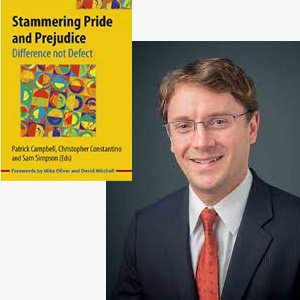This is a continuation of a series of reviews of selected articles featured in the text, Stammering Pride and Prejudice. In this essay, “How We Can Work Together To Decrease Stigma”, the “we” in the title refers to advocates for people who stutter and professional speech-language pathologists. Michael P. Boyle explains that while these two groups share many of the same goals, they are to some extent at odds. He describes ways the groups can collaborate and learn from each other.
Because Boyle is a person who stutters himself, as well as a speech language pathologist, clinician and researcher, he is well suited to examine this topic.
PWS, or advocates, often object to the emphasis on treatment and fluency emphasized by professionals; professionals, meanwhile, can resent the negative appraisals of stuttering treatment by some advocates who have had negative experiences. Divisions have grown in recent years.
Of course both groups share at least one major goal: the wish to decrease the stigma around stuttering, and to eradicate misconceptions about stuttering that exist in the general public. Professionals rely on conveying information through public ad campaigns and education. In accordance with a "services agenda," by reducing stigma and normalizing stuttering, PWS are less discriminated against and encouraged to seek treatment.
People who stutter, who advocate for themselves and others who stutter, don’t focus on an idea of “normalcy”, but seek to challenge social barriers and eliminate discrimination. Stuttering can be difficult, but there are also advantages in achieving resilience, being one's authentic self and celebrating our differences. Because they deal with challenges on a day to day basis, they don’t consult with professionals or research papers to determine how to respond. By way of a "rights agenda" they fight for accommodations at work and acceptance in society, sometimes spontaneously and instinctively.
Boyle points out that advocates can be more effective in this endeavour by being exposed to professional research on the topic, such as Ken St. Louis’ text, Stuttering Meets Stereotype, Stigma and Discrimination: An Overview of Attitude Research. St. Louis’ research reveals validated strategies to change public attitudes. Boyle himself has conducted research on the most effective ways to reach people and advocate for fair treatment of people who stutter. Not hiding stuttering, talking about it and having interpersonal contact with people is the best way to change attitudes.
Professionals, while still embracing the service agenda, can acknowledge the value of self-help groups and, while promoting treatment for stuttering, still recommend their clients get support from others who stutter. The real "experts" on stuttering are people who stutter, and getting their buy-in on the shape of the treatment is crucial. SLPs can acknowledge that stuttering isn't merely an individual problem, and contribute to advocacy at the institutional level and through public policy.
Michael P. Boyle has written an enlightening article that seeks to find ways to bridge the gap that has grown between advocates and professionals in the realm of stuttering, advocacy and treatment. By coming together on common goals, and acknowledging the strengths and weaknesses of each other's points of view and different agendas, more can be accomplished to reduce stigma and discrimination towards people who stutter.

